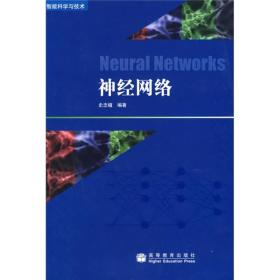
神经网络
¥ 18.75 2.6折 ¥ 73 八五品
库存2件
广东东莞
认证卖家担保交易快速发货售后保障
作者[印度]Satish Kumar
出版社清华大学出版社
出版时间2006-08
版次1
装帧平装
上书时间2024-07-25
- 最新上架
商品详情
- 品相描述:八五品
图书标准信息
- 作者 [印度]Satish Kumar
- 出版社 清华大学出版社
- 出版时间 2006-08
- 版次 1
- ISBN 9787302135524
- 定价 73.00元
- 装帧 平装
- 开本 其他
- 纸张 胶版纸
- 页数 736页
- 原版书名 Neural Networks: A Classroom Approach
- 【内容简介】
-
本书从理论和实际应用出发,全面系统地介绍神经网络的基本模型、基本方法和基本技术,涵盖了神经系统科学、统计模式识别、支撑向量机、模糊系统、软件计算与动态系统等内容。本书对神经网络的各种基本模型做了深入研究,对神经网络的最新发展趋势和主要研究方向也都进行了全面而综合的介绍,每章都包含大量例题、习题,对所有模型不仅给出了实际的应用示例,还提供了详细的MATHLAB代码,是一本很好的神经网络教材。
本书适合作为相关专业研究生或本科高年级学生的教材,也是神经网络的科研人员的参考书。 - 【目录】
-
Foreword
Prefac
More Acknowledgements
Part Ⅰ Traces of History and A Neuroscience Briefer
1. Brain Style Computing: Origins and Issues
1.1 From the Greeks to the Renaissance
1.2 The Advent of Modern Neuroscience
1.3 On the Road to Artificial Intelligence
1.4 Classical AI and Neural Networks
1.5 Hybrid Intelligent Systems
Chapter Summary
Bibliographic Remarks
2. Lessons from Neuroscience
2.1 The Human Brain
2.2 Biological Neurons
Chapter Summary
Bibliographic Remarks
Part Ⅱ Feedforward Neural Networks and Supervised Learning
3. Artificial Neurons, Neural Networks and Architectures
3.1 Neuron Abstraction
3.2 Neuron Signal Functions
3.3 Mathematical Preliminaries
3.4 Neural Networks Defined
3.5 Architectures: Feedforward and Feedback
3.6 Salient Properties and Application Domains of Neural Networks
Chapter Summary
Bibliographic Remarks
Review Questions
4. Geometry of Binary Threshold Neurons and Their Networks
4.1 Pattern Recognition and Data Classification
4.2 Convex Sets, Convex Hulls and Linear Separability
4.3 Space of Boolean Functions
4.4 Binary Neurons are Pattern Dichotomizers
4.5 Non-linearly Separable Problems
4.6 Capacity of a Simple Threshold Logic Neuron
4.7 Revisiting the XOR Problem
4.8 Multilayer Networks
4.9 How Many Hidden Nodes are Enough?
Chapter Summary
Bibliographic Remarks
Review Questions
5. Supervised LearningⅠ: Perceptrons and LMS
5.1 Learning and Memory
5.2 From Synapses to Behaviour: The Case of Aplysia
5.3 Learning Algorithms
5.4 Error Correction and Gradient Descent Rules
5.5 The Learning Objective for TLNs
5.6 Pattern Space and Weight Space
5.7 Perceptron Learning Algorithm
5.8 Perceptron Convergence Theorem
5.9 A Handworked Example and MATLAB Simulation
5.10 Perceptron Learning and Non-separable Sets
5.11 Handling Linearly Non-separable Sets
5.12 a–Least Mean Square Learning
5.13 MSE Error Surface and its Geometry
5.14 Steepest Descent Search with Exact Gradient Information
5.15 u–LMS: Approximate Gradient Descent
5.16 Application of LMS to Noise Cancellation
Chapter Summary
Bibliographic Remarks
Review Questions
6. Supervised Learning Ⅱ: Backpropagation and Beyond
6.1 Multilayered Network Architectures
6.2 Backpropagation Learning Algorithm
6.3 Handworked Example
6.4 MATLAB Simulation Examples
6.5 Practical Considerations in Implementing the BP Algorithm
6.6 Structure Growing Algorithms
6.7 Fast Relatives of Backpropagation
6.8 Universal Function Approximation and Neural Networks
6.9 Applications of Feedforward Neural Networks
6.10 Reinforcement Learning: A Brief Review
Chapter Summary
Bibliographic Remarks
Review Questions
7. Neural Networks: A Statistical Pattern Recognition Perspective
7.1 Introduction
7.2 Bayes’ Theorem
7.3 Two Instructive MATLAB Simulations
7.4 Implementing Classification Decisions with Bayes’ Theorem
7.5 Probabilistic Interpretation of a Neuron Discriminant Function
7.6 MATLAB Simulation: Plotting Bayesian Decision Boundaries
7.7 Interpreting Neuron Signals as Probabilities
7.8 Multilayered Networks, Error Functions and Posterior Probabilities
7.9 Error Functions for Classification Problems
Chapter Summary
Bibliographic Remarks
Review Questions
8. Focussing on Generalization: Support Vector Machines and Radial Basis Function Networks
8.1 Learning From Examples and Generalization
8.2 Statistical Learning Theory Briefer
8.3 Support Vector Machines
8.4 Radial Basis Function Networks
8.5 Regularization Theory Route to RBFNs
8.6 Generalized Radial Basis Function Network
8.7 Learning in RBFN’s
8.8 Image Classification Application
8.9 Other Models For Valid Generalization
Chapter Summary
Bibliographic Remarks
Review Questions
Part Ⅲ Recurrent Neurodynamical Systems
Part Ⅳ Contemporary Topics
Appendix A: Neural Network Hardware
Appendix B: Web Pointers
Bibliography
Index
点击展开
点击收起
相关推荐
— 没有更多了 —


















以下为对购买帮助不大的评价